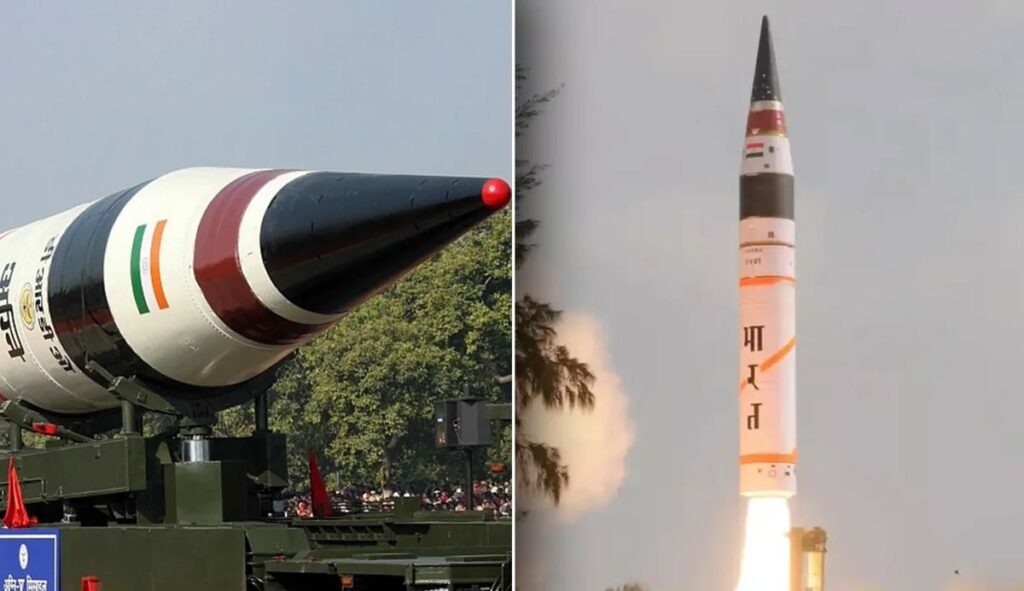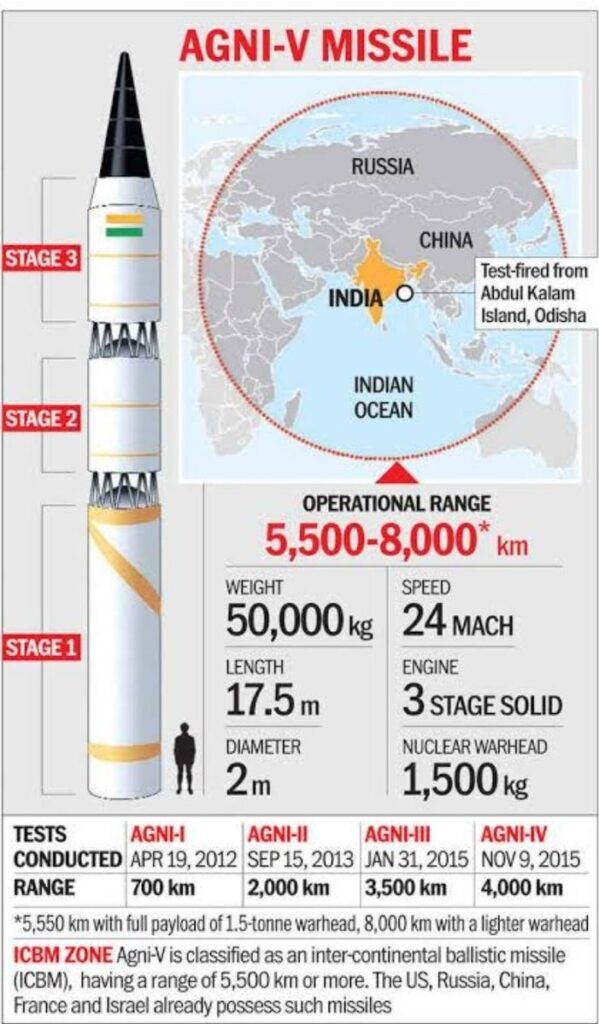In a defining moment for national security, India successfully test-fired the Agni-5 missile with a range of over 5,000 km, bringing nearly 60% of the world within its reach. The feat showcases India’s growing defense self-reliance while reinforcing its doctrine of credible minimum deterrence.
India’s defense capabilities have advanced significantly with this week’s successful test-fire of the Agni-5 intermediate-range ballistic missile (IRBM) from Abdul Kalam Island off the coast of Odisha. With a strike range of over 5,000 kilometers, the Agni-5 not only reinforces India’s deterrence capabilities but also demonstrates its steady progress in building a self-reliant defense ecosystem.
At a time when nearly 60% of the world’s population lives within the striking radius of the Agni-5, this achievement underlines India’s emergence as a formidable power in the global security architecture. The successful trial adds another layer of assurance to India’s long-standing doctrine of credible minimum deterrence and reflects its commitment to maintaining peace through strength.
The Test: A Precision Success
According to defense officials, the missile was launched during night hours to validate advanced guidance, propulsion, and re-entry systems. The trial was monitored by radars, telemetry, and tracking systems along the eastern coast and across Indian Ocean ranges.
Eyewitnesses from defense establishments reported that the three-stage, solid-fueled missile lifted off flawlessly, with all parameters functioning exactly as designed. With precise accuracy, the missile struck its target after traveling the whole range.
This wasn’t the first test of Agni-5, but what made this mission significant was its canisterized launch capability. Unlike older missile systems, Agni-5 can be stored in a hermetically sealed canister and launched on short notice, giving India’s armed forces both mobility and rapid deployment readiness.
A Legacy of the Agni Series
The Agni-5 is part of the larger Agni missile family, which has been central to India’s deterrence strategy for over three decades. The series began with Agni-I, a short-range ballistic missile, and has steadily progressed through longer ranges:
- Agni-I: 700–1,200 km
- Agni-II: 2,000–3,500 km
- Agni-III: 3,000–5,000 km
- Agni-IV: 3,500–4,000 km
- Agni-V: 5,000+ km
Each iteration has marked a significant leap in India’s indigenous missile development program, spearheaded by the Defence Research and Development Organisation (DRDO). Agni-5, however, is widely considered a game-changer because it takes India into the intercontinental strike capability bracket, even though officially it is classified as an “intermediate-range” system.
Technical Highlights of Agni-5
The Agni-5 is not just a missile; it’s a technological marvel that combines range, accuracy, and survivability. Some of its defining features include:
Range: Over 5,000 km, covering most of Asia and parts of Europe and Africa.
Propulsion: A three-stage, solid-propellant system ensures consistent performance and long shelf life.
Accuracy: Equipped with a Ring Laser Gyroscope-based Inertial Navigation System (RLG-INS) and advanced micro-navigation aids, ensuring minimal Circular Error Probability (CEP).
Payload: Able to transport a nuclear warhead up to 1.5 tons in weight.
Canisterization: A road-mobile, rail-mobile, and compact launch system that allows for quick deployment over a variety of terrains.
Re-entry Vehicle: Designed to withstand temperatures of over 4,000°C, ensuring payload integrity during atmospheric re-entry.
Defense analysts note that these features collectively make Agni-5 one of the most sophisticated missile systems in Asia.
Why This Test Matters Now
India’s successful test comes at a critical juncture in global geopolitics. With tensions simmering across the Indo-Pacific, and rival powers expanding their missile and nuclear programs, India’s demonstration of strategic readiness sends a clear message of deterrence and stability.
In recent years, China has significantly advanced its missile programs, including the DF-41 intercontinental ballistic missile (ICBM) with ranges exceeding 12,000 km. Similarly, Pakistan continues to expand its nuclear arsenal and delivery systems. Against this backdrop, Agni-5 provides India with a credible second-strike capability, reinforcing its nuclear doctrine of No First Use (NFU) but assured retaliation.
Strategic Implications
The Agni-5 test strengthens India’s position in multiple ways:
- Enhanced Deterrence
By covering almost all of Asia and parts of Europe, Agni-5 ensures that potential adversaries think twice before escalating conflicts. - Boost to India’s Nuclear Triad
India already has land-based, sea-based, and air-based nuclear delivery systems. The land-based component is strengthened with Agni-5, which guarantees survival even in the most dire circumstances. - Global Standing
With Agni-5, India joins an exclusive group of nations—including the US, Russia, China, France, and the UK—that possess long-range missile capability. - Message of Self-Reliance
The successful test highlights the growing capabilities of “Atmanirbhar Bharat” in defense, reducing dependence on foreign technology.
The Road Ahead: MIRV and Beyond
India’s missile program is always evolving, even if the Agni-5 is a technological marvel. Experts suggest that the next step could be integrating MIRV (Multiple Independently targetable Re-entry Vehicles) technology.
MIRV would allow a single Agni-5 missile to carry multiple nuclear warheads, each capable of hitting different targets. This would dramatically increase survivability against missile defense systems and amplify deterrence. Reports indicate that Agni-6, expected to be India’s next big leap, might incorporate such advancements.
Domestic and International Reactions
Domestically, the successful test was met with widespread acclaim. Defense Minister and senior officials congratulated DRDO scientists, emphasizing India’s commitment to peace through strength. The Indian Armed Forces also expressed confidence that Agni-5 would significantly enhance operational readiness.
Internationally, the response was measured. While strategic analysts acknowledged India’s technological success, some global think tanks expressed concerns about the ongoing arms race in Asia. India, however, reiterated that its program is defensive in nature and aligned with its NFU doctrine.
Balancing Power with Responsibility
India’s missile program has always walked a careful line—projecting strength without appearing aggressive. Unlike some nations, India is not a signatory to the Nuclear Non-Proliferation Treaty (NPT) but has consistently upheld principles of restraint and responsibility.
With Agni-5, India reinforces its reputation as a nation that builds powerful capabilities but uses them as a shield, not a sword.
A Leap Forward
Agni-5’s successful test is a strategic declaration rather than merely a military milestone. It represents India’s resolve to safeguard its sovereignty, its technological ingenuity, and its readiness to take on the challenges of an uncertain global order.
As India continues its march toward becoming a global power, weapons like Agni-5 are not just tools of deterrence but symbols of a nation determined to maintain peace by being prepared for war.
Related News: Read More





Pingback: Realme P4 Pro 5G with Next-Gen Features and a 7000mAh..